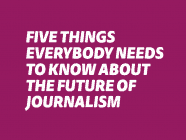Everyone loves The New Yorker. Or everyone loves talking about loving The New Yorker. Or, more realistically, everyone loves The New Yorker’s single-panel comics, and the rest of the magazine is certainly worth looking into when there’s time. While cartoons like those residing in The New Yorker’s plateau of sophistication remain less-common vehicles for news, they’re highly functional as a medium for serious nonfiction. Probing, investigative pieces of reportage and social commentary aren’t exclusively housed in monstrous, 9,000-word pieces of narrative journalism, although such beasts have obvious merit.
Graphic journalism (sometimes called “comics journalism”) is an experimental form of visual storytelling merging comic art with journalistic processes. It is, without question, an engaging way to reconfigure conventional notions of how we should consume news. Comic art and illustrations offer a powerful appeal to a different type of reader, capturing the attention of “under-targeted” audiences while keeping journalistic integrity in tact.
Early this December, the first iPad publication dedicated exclusively to graphic journalism was launched in the United States. Funded through grants from the McCormick’s New Media Women Entrepreneurs Initiative and the International Women’s Media Foundation, Symbolia is a tablet magazine of illustrated journalism. Stories in Symbolia appear entirely in comic form (the strip variety, à la Calvin & Hobbes), although spot animation, digital illustrations, sound and informative diagrams are also incorporated into stories. According to a CJR article, Symbolia employs fact-checkers, artists are paid between $200-$800 per piece, and at least half of all contributors will be women. To be clear: they are dancing with the devil.
While the approach is undeniably creative, graphic journalism endeavors may not be taking the news industry by storm. Newsrooms work on tiny budgets and cutthroat deadlines, and the production of meaningful, high-quality illustrations can be time-consuming and costly. The number of viable outlets remains small, however the work of exceptional talents like Dan Archer may help foster integration of graphic journalism within more traditional news formats. Archer has been fusing comics and journalism for years, creating annotated comics as a Knight Journalism Fellow at Stanford. Reporting on human trafficking from Kathmandu, Nepal, he recently published a sample of his graphic reportage on Poynter.org. Aside from pushing boundaries of what news “should” look like, Archer addresses the interesting functional advantage of his work, explaining, “I chose Nepal because visuals have huge potential here to reach at-risk communities with low literacy levels. Using comics to adapt survivor testimonies into a visual format preserves both the impact of the story as well as the identity of the storytellers.”
He goes on to explain how drawing subjects and scenes circumnavigates the undesirability and perceived insensitivity of camera gear. As opposed to film or video documentation, drawing can serve as a less abrasive means of capturing the nuance of an event without setting subjects on edge or forcing them to interact with equipment.
For more on graphic journalism, check out Cartoon Movement and Symbolia.
Photo credits: uniondocs / Flickr CC
Tags: Cartoon, Cartoon Movement, Columbia Journalism Review, Comics, Dan Archer, Graphic Journalism, iPad, Journalism, Kate Nacy, Print publishing, Publishing, Symbolia, The New Yorker














































